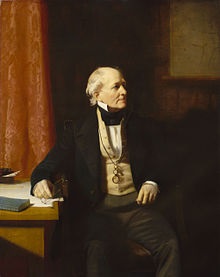 |
| Sir Francis
Beaufort. |
Beaufort Scale
The Beaufort scale /ˈboʊfərt/ is an empirical measure
that relates wind speed to observed conditions at sea or
on land. Its full name is the Beaufort wind force scale.
History
The scale was devised in 1805 by the Irish hydrographer
Francis Beaufort (later Rear Admiral), a Royal Navy
officer, while serving on HMS Woolwich. The scale that
carries Beaufort's name had a long and complex evolution
from the previous work of others (including Daniel Defoe
the century before) to when Beaufort was Hydrographer of
the Navy in the 1830s when it was adopted officially and
first used during the voyage of HMS Beagle under Captain
Robert FitzRoy who was later to set up the first
Meteorological Office (Met Office) in Britain giving
regular weather forecasts. In the 18th century, naval
officers made regular weather observations, but there
was no standard scale and so they could be very
subjective – one man's "stiff breeze" might be another's
"soft breeze". Beaufort succeeded in standardising the
scale.
The initial scale of thirteen classes (zero to twelve)
did not reference wind speed numbers but related
qualitative wind conditions to effects on the sails of a
frigate, then the main ship of the Royal Navy, from
"just sufficient to give steerage" to "that which no
canvas sails could withstand".
The scale was made a standard for ship's log entries on
Royal Navy vessels in the late 1830s and was adapted to
non-naval use from the 1850s, with scale numbers
corresponding to cup anemometer rotations. In 1853, the
Beaufort scale was accepted as generally applicable at
the First International Meteorological Conference in
Brussels.
In 1916, to accommodate the growth of steam power, the
descriptions were changed to how the sea, not the sails,
behaved and extended to land observations. Rotations to
scale numbers were standardized only in 1923. George
Simpson, CBE (later Sir George Simpson), director of the
UK Meteorological Office, was responsible for this and
for the addition of the land-based descriptors. The
measures were slightly altered some decades later to
improve its utility for meteorologists. Nowadays,
meteorologists typically express wind speed in
kilometers per hour or miles per hour, but Beaufort
scale terminology is still used for weather forecasts
for shipping and the severe weather warnings given to
the public. |
|
Extended scale
The Beaufort scale was extended in 1946 when forces 13
to 17 were added. However, forces 13 to 17 were
intended to apply only to special cases, such as
tropical cyclones. Nowadays, the extended scale is only
used in Taiwan and mainland China, which are often
affected by typhoons. Internationally, WMO Manual on
Marine Meteorological Services (2012 edition) defined
the Beaufort Scale only up to force 12 and there was no
recommendation on the use of the extended scale. |
|